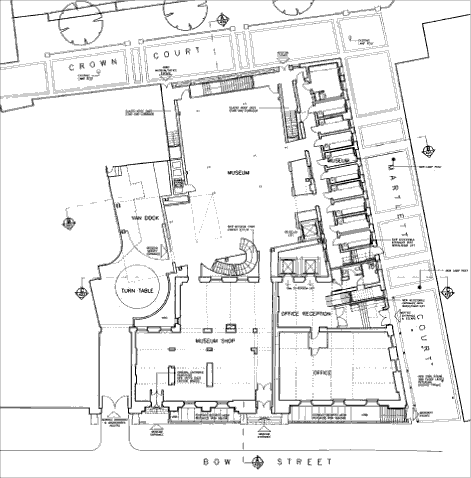

Ground floor plan
of the Museum, showing the proposed landscaping of Crown Court and Martlett
Court.
Click image for a high resolution version.
It will give equal prominence to explaining modern policing, providing interactive experiences of police tasks, and displaying police memorabilia from the force's large collections.
Once visitors go through the door they would cease to be just observing the police. Instead, they would be immersed in trying out policing tasks. Through this they would feel the emotions and social pressures which affect police officers, would see how technology is used to fight crime or maintain order, and would hear the true stories of past policing. The concept owes something to the success of interactive science centres but takes the approach into more emotional territory. This is far more fun than simply observing the police's museum exhibits and will minimise the obstruction to understanding which can arise from prejudices about the police.
The tone will be informative - and neutral with regard to contentious matters. However the designers feel that London's extraordinary success is rooted in the stability provided by sound policing, and this should be evident. Foreign tourists would have a rare insight into the culture and history of London and should leave with a good understanding of the advantages of the British approach to policing.
This kind of museum needs to be kept up to date and it will be designed in the form of a wide variety of "scenarios" each of which can be replaced at any time. Within each of these scenarios the visitors will be able to undertake tasks, either individually or collectively of the kind that an officer might meet on the beat.
The scenarios will come from various historic periods, and will feature all kinds of additional information. Their subject matter will be quite diverse and, for example, might include detecting burglary, crowd management, traffic control, major accident recovery, identifying suspects, counterfeiting, domestic incidents, using dogs to detect drugs and explosives, river policing, preventing shops or pubs giving short measure, mounted police and searching for fugitives. There will also be a courtroom for mock trials.
Emotions might be triggered by a visit to the old cells, and by a full presentation of the way in which all of the former Police Station was used at different times. The history of policing London and the story of Bow Street itself as the historic location for police and magistrates would be told. Records and historic objects lent to the museum by the police will add to its interest and authenticity, and provide a deep resource of further information for those who are most interested.
The proposed title for the museum is THE BEAT, chosen to reflect the variety and uncertainty of normal police work.
In a typical year about 28 million tourists come to London. Roughly half of these are from overseas and the other half from other parts of the UK. The Beat will try to attract 1% of these tourists.
